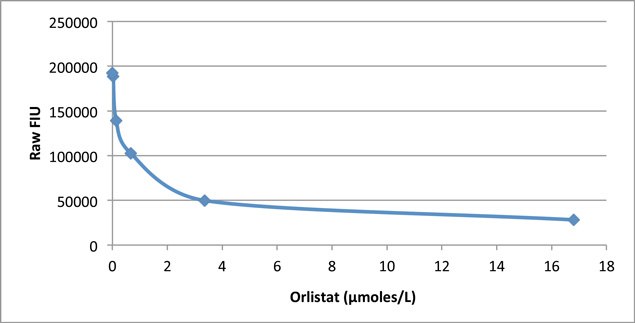LPL Activity Assay Protocol
Supplied by Roar Biomedical, Inc.
Product No. MAK109
Storage Temperature 2–8 °C
Components
The kit is sufficient for 100 assays in 200 µL total assay volume.
Reagents and Equipment Required but Not Provided
- 96 well U-bottom black plates for fluorescence assays.
- 37 °C water bath incubator
- Fluorescence multiwell plate reader
- Orlistat (Product No. O4139), for assay validation
Precautions and Disclaimer
This product is for R&D use only, not for drug, household, or other uses. Please consult the Safety Data Sheet for information regarding hazards and safe handling practices.
Preparation Instructions
Briefly centrifuge vials before opening.
Substrate Emulsion – Vortex before use.
Storage/Stability
The kit is shipped on wet ice. Storage at 2–8 °C, protected from light, is recommended. DO NOT FREEZE.
Components are stable for 1 year, if stored properly.
Procedure
All samples and standards should be run in duplicate.
Standards for Fluorometric Detection
Note: Standards are not to be incubated with samples, use a separate plate for assay of standards.
- Disperse 1 µL of the LPL Standard into 2.5 mL of LPL Assay Buffer to generate a 30.3 µM standard solution. Make 8–12 additional 2-fold serial dilutions (use at least 0.1 mL of previous standard solution and 0.1 mL of LPL Assay Buffer), generating standards with decreasing concentrations of LPL.
- Add 0.2 mL of each dilution to a fluorescent compatible microplate Measure the fluorescence intensity (λex = 370/λem = 450 nm). 0.2 mL of LPL Assay Buffer is used as the 0 (Blank) Standard (see Table 1.).
- Plot a standard curve (FIU to nmoles of label) and determine the slope (m) and intercept (b). This is the standard curve for calculating nmoles of reacted substrate from fluorescence intensity units.
Sample Preparation
- Set up the Master Reaction Mix according to the scheme in Table 2. Add 195 mL of the Master Reaction Mix to each reaction (well).
Note: The substrate is in a liquid crystalline state and difficult to pipette accurately in small volumes. It is suggested to pipette the substrate using a wide barrel pipette tip, or by cutting the end off of a standard pipette tip.
- Add 5 µL of desired LPL source (plasma or serum, fresh or frozen) to the appropriate wells. To a sample blank, add 5 µL of LPL Assay Buffer in place of LPL source.
Notes: For unknown samples, it is suggested to test several sample dilutions to ensure the readings are within the linear range of the standard curve.
The amount of LPL to use in the assay and the incubation temperature will depend on the specific activity of the protein. For example, a purified sample of LPL with high specific activity may require dilution with LPL Assay Buffer and/or incubation at 25 °C in order for the assay to provide a linear response. It is recommended first time users start with a lower temperature, ~15 minute incubation time points, and multiple reads to work out a set of conditions.
Assay Reaction
- Seal plate and incubate for 15–60 minutes at 25–37 °C.
- Measure the increase in fluorescence of samples using a fluorometer (λex = 370/λem = 450 nm). Determine the fluorescence intensity of the plasma or serum samples by subtracting the fluorescence intensity of the sample blank from each sample.
- Calculate nanomoles of label in the assay by subtracting the intercept (b) from (y) and then dividing by the slope (m) of the standard curve.
Assay Validation Procedure
The steps to validate the assay were adapted from a published procedure,1 using Orlistat (Product No. O4139), also known as tetrahydrolipstatin (THL), to inhibit LPL activity.
Note: LPL as an ammonium sulfate suspension (Product No. L2254) will NOT be inhibited by orlistat. Other sources of LPL without ammonium sulfate, including bacterial LPL (Product No. 62335), work well to validate the assay with inhibitor.
- Bacterial LPL (Product No. 62335, 3.3 mg/mL), was dissolved in 10 mM Tris HCL, pH 8.5, with 4 mM sodium deoxycholate (Product No. 30970) and 0.1 mM linoleic acid (Product No. L1376). with different concentrations of.
- Orlistat dissolved in DMSO (Product No. W387509) was added to final concentrations of 16.8, 3.36, 0.67, 0.13, 0.027, and 0 µM.
- After incubation for 10 minutes at 20 °C, 10 µL aliquots were removed and the activity was determined according to the assay procedure.

Figure 1.LPL Activity Assay Inhibition with Orlistat
Materials
References
To continue reading please sign in or create an account.
Don't Have An Account?